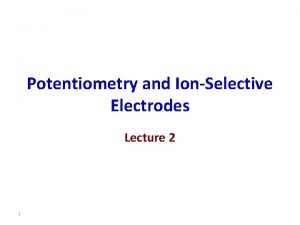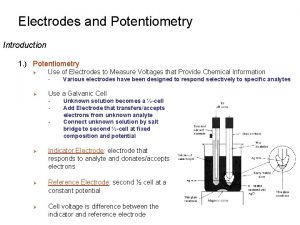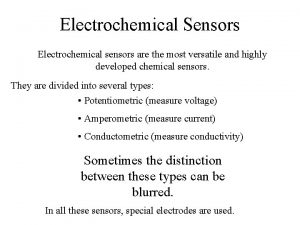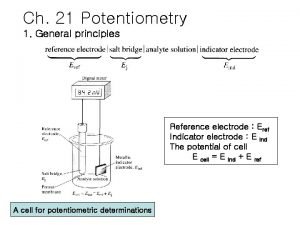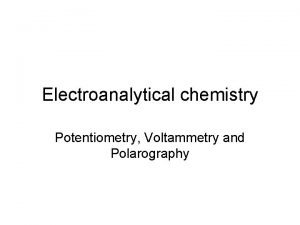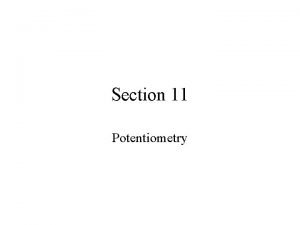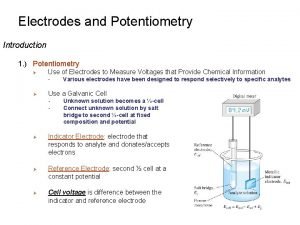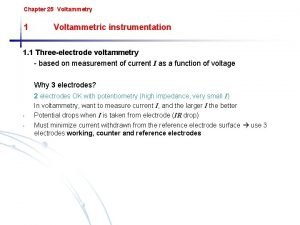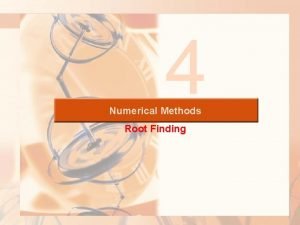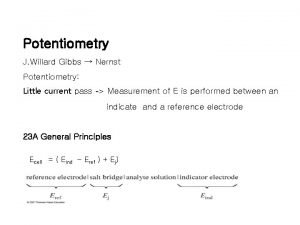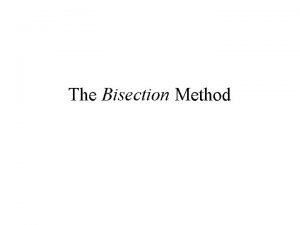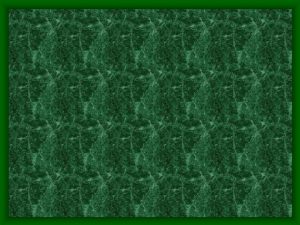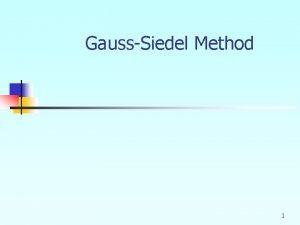Potentiometry Potentiometry is an electroanalyticl method in which



















- Slides: 19

Potentiometry - Potentiometry is an electroanalyticl method in which potential of a cell is measured in the absence of a significant current. - By performing potentiometry it is required to determine the concentration of some chemical species (the analyte) - An electrochemical cell is required to measure an electrode potential (the indicator electrode). - The indicator electrode acts as a sensor responding to the activity of the analyte. - The cell required for this purpose includes two electrodes, a reference electrode and the indicator electrode beside a potential measuring device.

The potential of the indicator electrode should be reversible, reproducible and ideally related to the analyte concentration only. - The measured potential is proportional to the activity of the analyte (or to the concentration, indirectly, through the activity coefficient γ: a= γm) - For dilute solutions when the activity coefficient approaches unity, activity can be replaced by concentration

Reference Electrodes - Characteristics of an Ideal Reference Electrodes - Reversible and obeys the Nernst equation - Its potential should be known and constant with time - Returns to its original potential after being subjected to small currents -Little hysteresis with temperature cycling

Examples of reference electrodes -Standard hydrogen electrode (SHE) • - The calomel electrode (example: the saturated calomel electrode, SCE, easy to prepare but when temperature changes it takes a long time to attain equilibrium) - The Silver/Silver chloride electrode (an advantage is that it can be used at temperatures higher than 60°C)

1 - Indicator electrodes The potential of these electrodes is a function of the concentration of the analyte. two types will be discussed: 1 - metallic indicator electrodes 2 - ion selective membrane electrode

Metallic indicator electrodes Metals like silver, provide a surface for the electrochemical reaction and allow reversible reactions (electrons transfer to or from species in solution) are used as a sensor for their ions. - The potential develops on them with the tendency of the redox reaction to occur Example: Using a silver electrode with the calomel reference electrode allows for the direct determination of the activity of Ag+ (metallic indicator electrode of the first kind).

Metallic indicator electrodes of the first kind A metal can be used to detect its own ions EX: a strip of copper immersed in a solution containing Cu 2+ Here the copper electrode is used for the determination of the Cu 2+ activity Cu 2+ + 2 e = Cu(s) Eind = E 0 Cu – (0. 0591/2) log 1/a. Cu 2+ Eind = E 0 Cu – (0. 0591/2) p. Cu (The last equation says that the potential of the indicator electrode is related to p. Cu) Other metals that behave reversibly include, silver, mercury, cadmium, zinc and lead (so, they can be used to determine their ions). Metals that behave irreversibly like Fe, Ni, Co etc (cannot be used for the determination of their ions.

Metallic indicator electrodes of the second kind: An anion can be detected and determined by a cation with which this anion makes a complex, a sparingly soluble salt, etc. Ex. Cl- can be determined using the silver electrode. Because they form Ag. Cl (sparingly soluble salt) A layer of Ag. Cl is deposited on the surface of a silver wire acts as the electrode when immersed in a solution containing silver ions the following reaction is considered: Ag. Cl(s) + e = Ag(s) + Cl. Eind = 0. 222 – 0. 0591 log a. Cl. Eind = 0. 222 + 0. 0592 p. Cl

Ion selective electrodes of the third kind A metal electrode responds to a different metal ion Example: Mercury can be used to detect Ca 2+ Mercury forms a stable complex with EDTA and can be used as an electrode of the second kind for the determination of EDTA (Y 4 -) A small volume of Hg. Y 2 - , added to the analyte solution, is required - the indicator electrode potential is: Eind = K- (0. 0591/2) log a. Y 4 Ca 2+ also can form a complex with EDTA: Ca. Y 2 - = Ca 2+ + Y 4 The formation constant of the complex, Kf = a. Ca. Y 2 - /a. Ca 2+ a. Y 4 - = a. Ca. Y 2 - /Kf. a. Ca 2+ -

• Substitution by the value of a. Y 4 - into the previous expression (Eind= K- (0. 0591/2) log a. Y 4 -) gives: Eind= K´- 0. 0591/2. log 1/a. Ca 2+ Eind= K´- (0. 0591/2) p. Ca where, K´= k – (0. 0591/2)log a. Ca. Y 2 -/kf. To use the electrode, a small volume of the Ca. Y 2 - is added to the test solution The same volume should be used for standardization

Metallic redox indicators Inert metals like Pt can be used as indicator electrodes for redox reactions like Ox + ne = Red Eind = E°- 0. 0591/1 log a. Red/a. Ox Eind = E°+ 0. 0591/1 log a. Ox/a. Red Obviously, the electrode potential Eind is dependent on the ratio a. Ox/a. Red To use the electrode for a redox reaction it must be reversible (these electrodes can not be used for a reaction that do not proceed reversibly on electrode surface)

2 - Ion-Selective Membrane Electrodes The potential is developed across a membrane that separating the investigated solution from a reference one as a kind of junction potential. The selective binding of the analyte species with the surfaces of the membrane generates an electric potential - The electric potential develops across the membrane due to the difference in activity of the ion on the two sides of the membrane.

Properties of Ion-Selective Electrodes: - Minimal solubility of the ion-selective membrane in the analyte solution - Electrical conductivity (movement or migration of ions) - Selective reactivity with analyte (ion-exchange, crystallization, or complexation).

Glass Electrodes for measuring p. H - Two reference electrodes (the calomel and the Ag/Ag. Cl) are required to measure the potential difference across the glass membrane. - The Ag/Ag. Cl reference electrode is slightly modified to include a thin glass membrane at the bottom which is the sensor and is selective to H+. The thin glass is made of silicate as the major component. Other species exists like sodium, calcium, …. Conduction within the membrane is through the movement of the singly charged cation (sodium). Conduction across the surface hydrated gel layer of the membrane is through H+ H+ + Gl- = H+Gl-


The thin glass membrane separates an inner solution of the electrode from the outer solution (the test solution) the outer surface of the membrane exchanges its cations (Na+) with H+ from the solution H+ + Na+Gl- = Na+ + H+Gl. The potential of the glass electrode depends on the ratio of activity of protons on the outer side and the inner side The of activity of protons on the outer side depends on the activity of H + in the tested solution the activity of H+ in the inner side is supposed to be fixed The potential across the membrane, the boundary potential, Eb= E 1 -E 2 E 1 is related to outer surface of the glass membrane, the activity of H + in the test solution (a 1) E 2 is related to the inner surface of the glass membrane, activity of H + in the inner solution (a 2) Ecell for the previous cell for p. H measurements consists of four potentials, Eref 1, Ej , Eb , Eref 2

The potential of the glass electrode is related to p. H as: Eind =L – 0. 0591 p. H L is a constant However, the electrode may respond to alkaline ions (Li+, Na+, … ). High concentrations of these species causes the p. H to be lower than the true p. H (yielding alkaline error). - In strong acid solutions, the measured p. H is always higher than the actual p. H because the glass surface becomes saturated with H +

Calibration of the Glass Electrodes - Glass electrodes must always be calibrated. - Calibration is done using standard buffer solutions. - The electrode must be soaked in water before it can function as a sensor for H+, dry glass cannot function as a sensor for H+ -p. H is measured at a specific temperature -Generally, calibration is required when potentiometry is directly used to determine the activity of an analyte.

Determination of the equivalence point in neutralization reactions using a p. H-meter Example, determination of the concentration of HCl using a standard solution of Na. OH The p. H of HCl (a known volume V 1 is used) is determine while the standard solution of Na. OH (concentration, N 2) is added. A curve is constructed of p. H vs. the added volume (V) of Na. OH The required volume (V 2) of Na. OH solution which is equivalent to HCl (at the end point) can be determined from the point of inflection of the rising potion of the curve. The concentration of the analyte (N 1) is determined from the following relation: N 1 V 1(HCl)=N 2 V 2(Na. OH)
 Which cell is used in potentiometry
Which cell is used in potentiometry Potential of the glass electrode is given by
Potential of the glass electrode is given by Voltammetry vs amperometry
Voltammetry vs amperometry Types of indicator electrode in potentiometry
Types of indicator electrode in potentiometry Difference between conductometry and potentiometry
Difference between conductometry and potentiometry Reference and indicator electrode
Reference and indicator electrode Polarizable and non polarizable electrode
Polarizable and non polarizable electrode Drop mercury electrode
Drop mercury electrode Potentiometry
Potentiometry Potentiometric titration
Potentiometric titration Instrumentation of voltammetry
Instrumentation of voltammetry Difference between voltammetry and potentiometry
Difference between voltammetry and potentiometry What is symposium method
What is symposium method Birge-vieta method uses formula of which method
Birge-vieta method uses formula of which method Pour plate method steps
Pour plate method steps Bilingual method merits and demerits
Bilingual method merits and demerits Bracketing method and open method
Bracketing method and open method Design philosophy of steel structure
Design philosophy of steel structure Isolation and preservation of pure culture
Isolation and preservation of pure culture Wet gum method is also known as
Wet gum method is also known as

